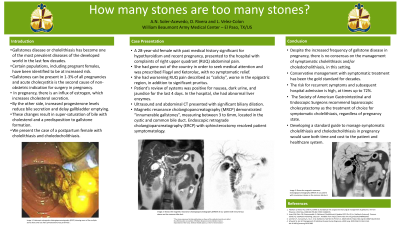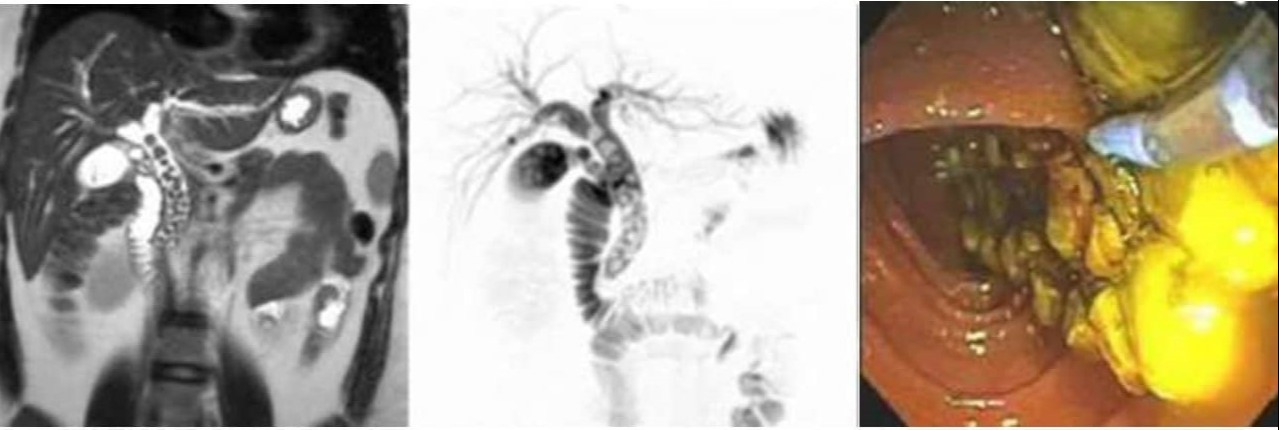Back


Poster Session C - Monday Afternoon
Category: Interventional Endoscopy
C0478 - How Many Stones Are Too Many Stones?
Monday, October 24, 2022
3:00 PM – 5:00 PM ET
Location: Crown Ballroom

Has Audio

Ashley Soler-Acevedo, MD
William Beaumont Army Medical Center
El Paso, TX
Presenting Author(s)
Ashley Soler-Acevedo, MD, Orlando Rivera, MD, Luis Velez-Colon, MD
William Beaumont Army Medical Center, El Paso, TX
Introduction: Gallstones disease or cholelithiasis has become one of the most prevalent diseases of the developed world in the last few decades. Certain populations, including pregnant females, have been identified to be at increased risk. Gallstones can be present in 1-3% of all pregnancies and acute cholecystitis is the second cause of non-obstetric indication for surgery in pregnancy. In pregnancy, there is an influx of estrogen, which increases cholesterol secretion. By the other side, increased progesterone levels reduce bile secretion and delay gallbladder emptying. These changes result in super-saturation of bile with cholesterol and a predisposition to gallstone formation. We present the case of a postpartum female that presented with cholelithiasis and choledocholithiasis.
Case Description/Methods: A 28-year-old female with past medical history significant for hypothyroidism and recent pregnancy, presented to the hospital with complaints of right upper quadrant (RUQ) abdominal pain. She had gone out of the country in order to seek medical attention and was prescribed Flagyl and Ketorolac, with no symptomatic relief. She had worsening RUQ pain described as “colicky”, worse in the epigastric region, in addition to significant pruritus. Patient’s review of systems was positive for nausea, dark urine, and jaundice for the last 4 days. In the hospital, she had abnormal liver enzymes. Ultrasound and abdominal CT presented with significant biliary dilation. Magnetic resonance cholangiopancreatography (MRCP) demonstrated “innumerable gallstones”, measuring between 3 to 6mm, located in the cystic and common bile duct. Endoscopic retrograde cholangiopancreatography (ERCP) with sphincteroctomy resolved patient symptomatology.
Discussion: Despite the increased frequency of gallstone disease in pregnancy, there is no consensus on the management of symptomatic cholelithiasis and/or choledocholithiasis, in this setting. Conservative management with symptomatic treatment has been the gold standard for decades. However, the risk for recurrent symptoms and subsequent hospital admission is high, at times up to 72%. The Society of American Gastrointestinal and Endoscopic Surgeons recommend laparoscopic cholecystectomy as the treatment of choice for symptomatic cholelithiasis, regardless of pregnancy state. Developing a standard guide to manage symptomatic cholelithiasis and choledocholithiasis in pregnancy would save both time and cost to the patient and healthcare system.

Disclosures:
Ashley Soler-Acevedo, MD, Orlando Rivera, MD, Luis Velez-Colon, MD. C0478 - How Many Stones Are Too Many Stones?, ACG 2022 Annual Scientific Meeting Abstracts. Charlotte, NC: American College of Gastroenterology.
William Beaumont Army Medical Center, El Paso, TX
Introduction: Gallstones disease or cholelithiasis has become one of the most prevalent diseases of the developed world in the last few decades. Certain populations, including pregnant females, have been identified to be at increased risk. Gallstones can be present in 1-3% of all pregnancies and acute cholecystitis is the second cause of non-obstetric indication for surgery in pregnancy. In pregnancy, there is an influx of estrogen, which increases cholesterol secretion. By the other side, increased progesterone levels reduce bile secretion and delay gallbladder emptying. These changes result in super-saturation of bile with cholesterol and a predisposition to gallstone formation. We present the case of a postpartum female that presented with cholelithiasis and choledocholithiasis.
Case Description/Methods: A 28-year-old female with past medical history significant for hypothyroidism and recent pregnancy, presented to the hospital with complaints of right upper quadrant (RUQ) abdominal pain. She had gone out of the country in order to seek medical attention and was prescribed Flagyl and Ketorolac, with no symptomatic relief. She had worsening RUQ pain described as “colicky”, worse in the epigastric region, in addition to significant pruritus. Patient’s review of systems was positive for nausea, dark urine, and jaundice for the last 4 days. In the hospital, she had abnormal liver enzymes. Ultrasound and abdominal CT presented with significant biliary dilation. Magnetic resonance cholangiopancreatography (MRCP) demonstrated “innumerable gallstones”, measuring between 3 to 6mm, located in the cystic and common bile duct. Endoscopic retrograde cholangiopancreatography (ERCP) with sphincteroctomy resolved patient symptomatology.
Discussion: Despite the increased frequency of gallstone disease in pregnancy, there is no consensus on the management of symptomatic cholelithiasis and/or choledocholithiasis, in this setting. Conservative management with symptomatic treatment has been the gold standard for decades. However, the risk for recurrent symptoms and subsequent hospital admission is high, at times up to 72%. The Society of American Gastrointestinal and Endoscopic Surgeons recommend laparoscopic cholecystectomy as the treatment of choice for symptomatic cholelithiasis, regardless of pregnancy state. Developing a standard guide to manage symptomatic cholelithiasis and choledocholithiasis in pregnancy would save both time and cost to the patient and healthcare system.

Figure: Image 1: Shows the magnetic resonance cholangiopancreatography (MRCP) of our patient with numerous stones on the common bile duct Panel 1 and 2). Endoscopic retrograde cholangiopancreatography (ERCP) showing some of the multiple stones that came out after sphincterotomy was performed (Panel 3).
Disclosures:
Ashley Soler-Acevedo indicated no relevant financial relationships.
Orlando Rivera indicated no relevant financial relationships.
Luis Velez-Colon indicated no relevant financial relationships.
Ashley Soler-Acevedo, MD, Orlando Rivera, MD, Luis Velez-Colon, MD. C0478 - How Many Stones Are Too Many Stones?, ACG 2022 Annual Scientific Meeting Abstracts. Charlotte, NC: American College of Gastroenterology.
